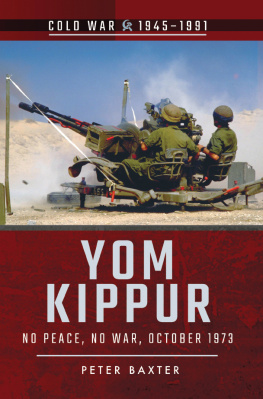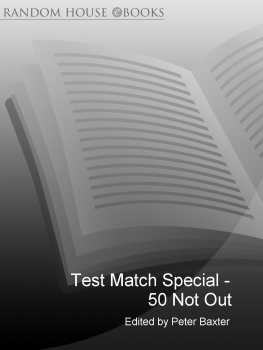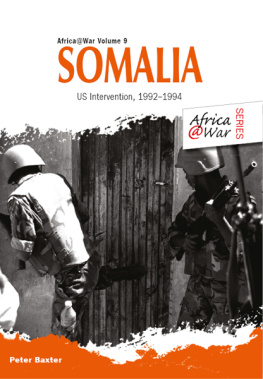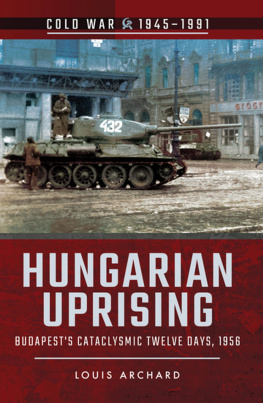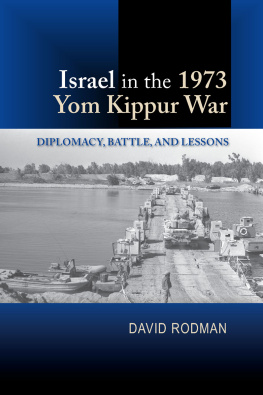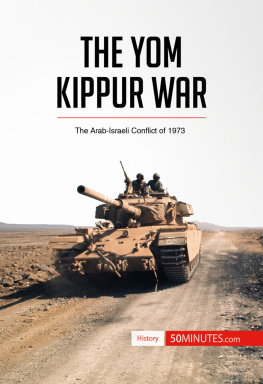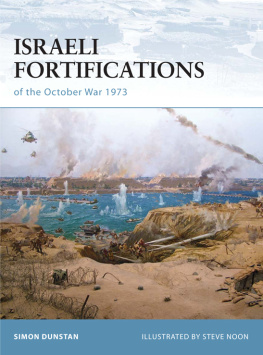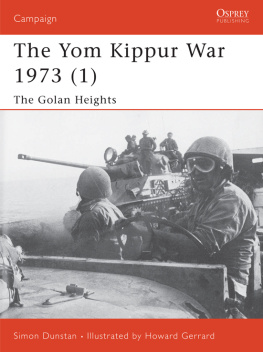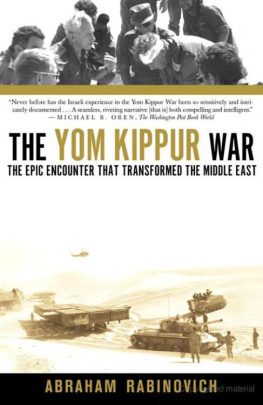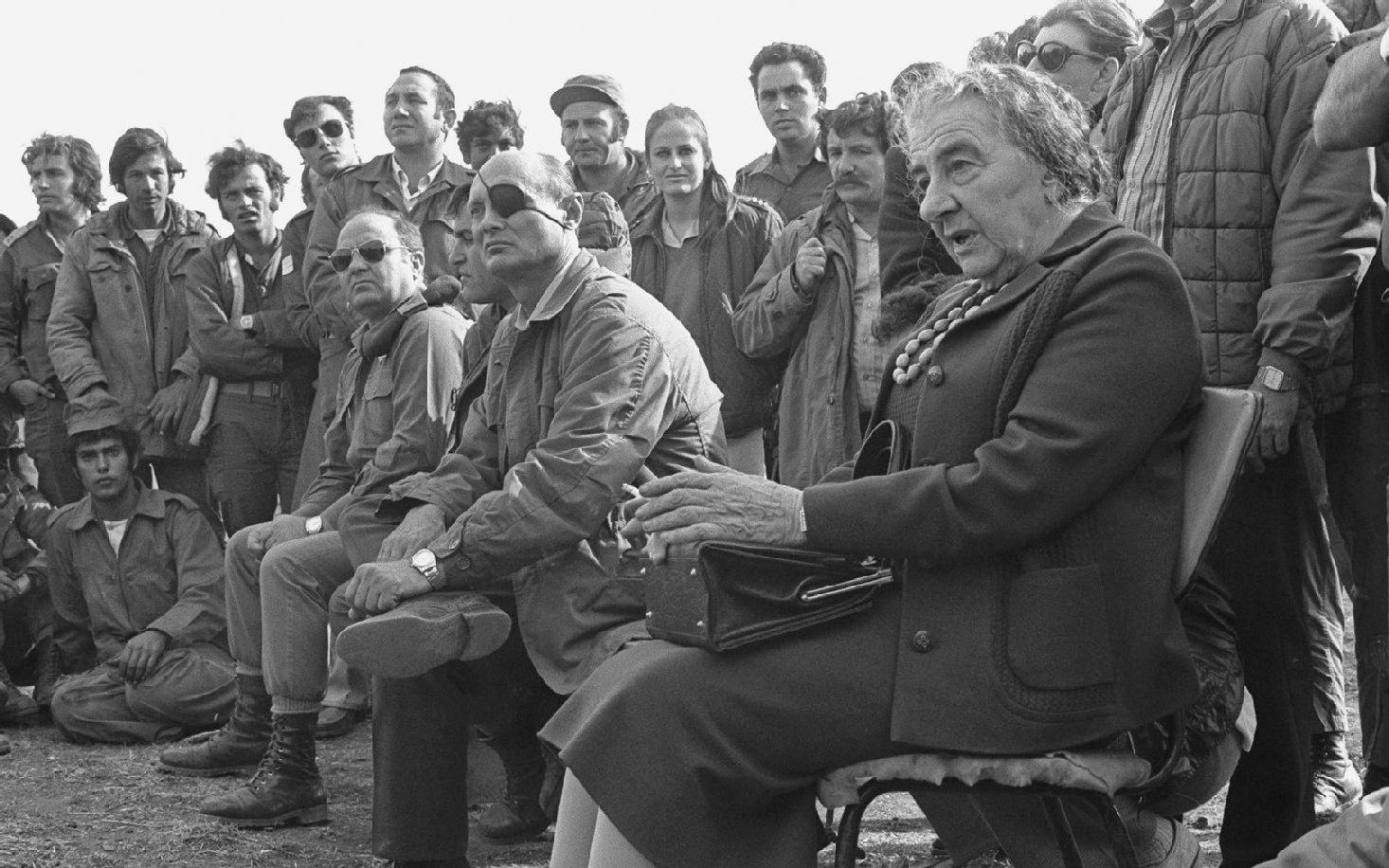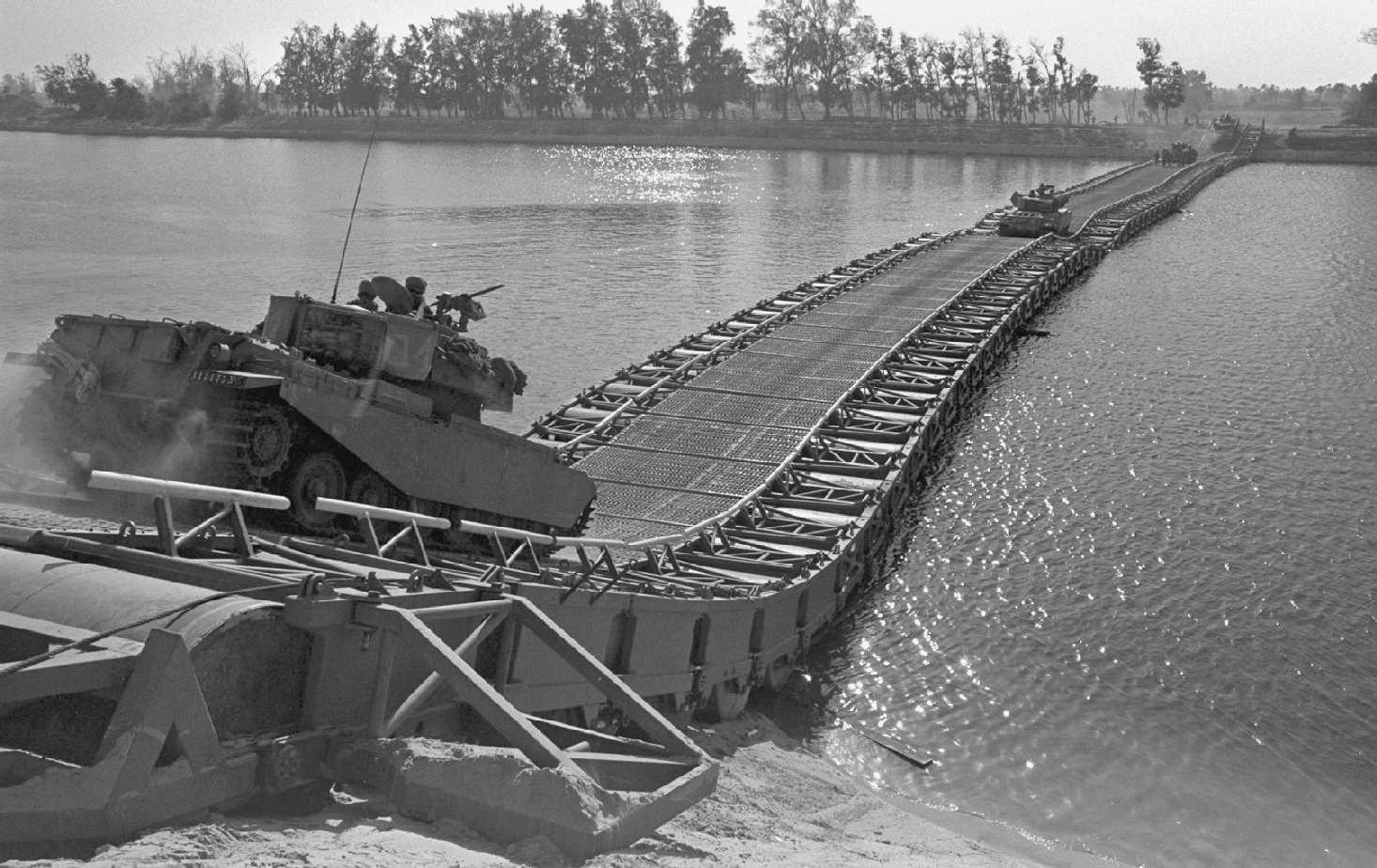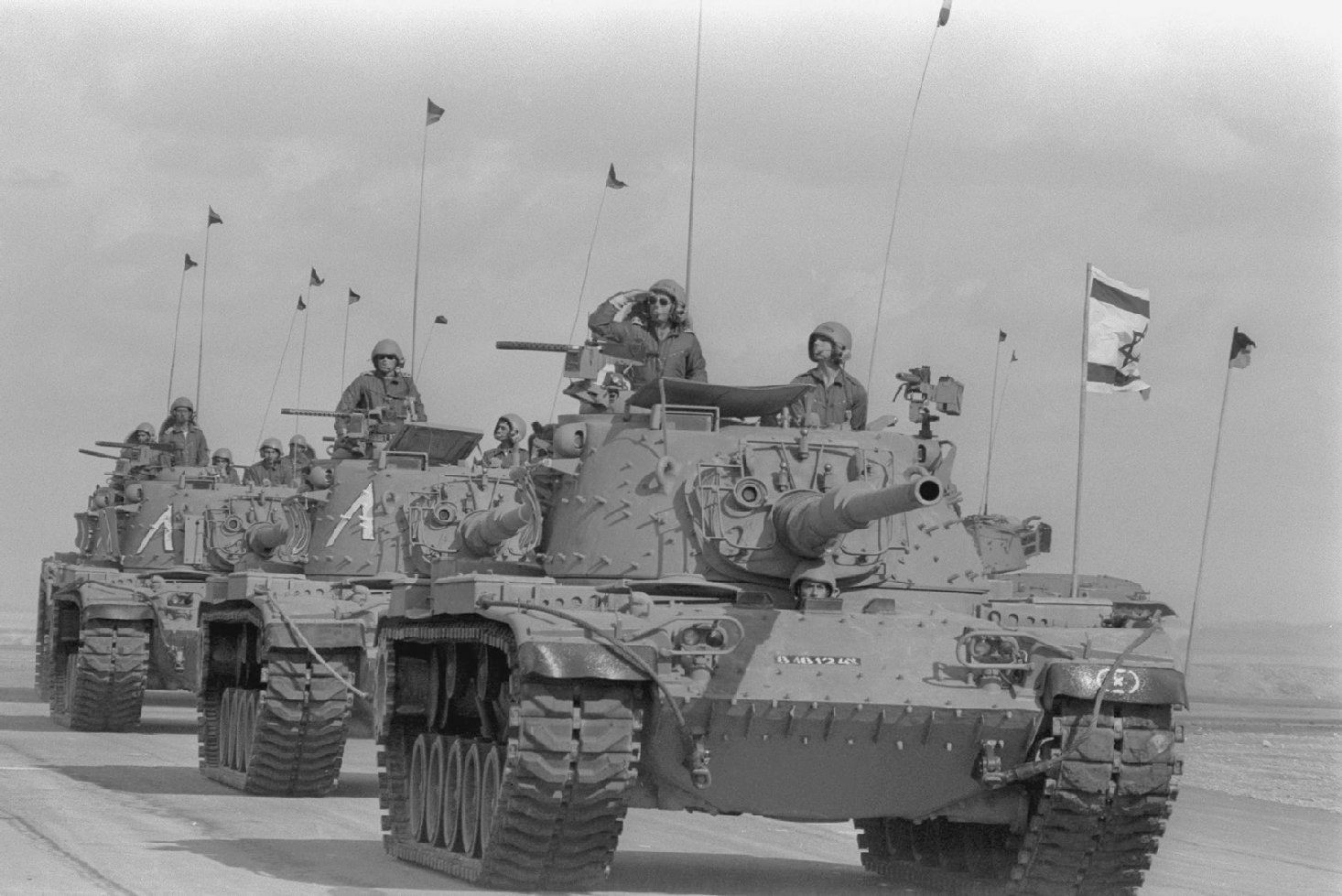
YOM KIPPUR
NO PEACE, NO WAR: OCTOBER 1973
PETER BAXTER
Grateful thanks to the Government Press Office (GPO)
in the Prime Ministers Office of the State of Israel
for their very kind permission for the use of images from their comprehensive
National Photo Collection found on their website http://gpoeng.gov.il/
The cover photos are also courtesy of GPO
First published in Great Britain in 2017 by
PEN AND SWORD MILITARY
an imprint of
Pen and Sword Books Ltd
47 Church Street
Barnsley
South Yorkshire S70 2AS
Copyright C.M. Cocks, 2017
ISBN 978 1 52670 790 1
eISBN 978 1 52670 792 5
Mobi ISBN 978 1 52670 791 8
The right of Peter Baxter to be identified as the author of this work has been asserted in accordance with the Copyright, Designs and Patents Act 1988.
A CIP record for this book is available from the British Library All rights reserved.
No part of this book may be reproduced or transmitted in any form or by any means, electronic or mechanical including photocopying, recording or by any information storage and retrieval system, without permission from the Publisher in writing.
Every reasonable effort has been made to trace copyright holders of material reproduced in this book, but if any have been inadvertently overlooked the publishers will be pleased to hear from them.
Pen & Sword Books Ltd incorporates the imprints of Pen & Sword Archaeology, Atlas, Aviation, Battleground, Discovery, Family History, History, Maritime, Military, Naval, Politics, Railways, Select, Social History, Transport, True Crime, Claymore Press, Frontline Books, Leo Cooper, Praetorian Press, Remember When, Seaforth Publishing and Wharncliffe.
For a complete list of Pen and Sword titles please contact
Pen and Sword Books Limited
47 Church Street, Barnsley, South Yorkshire, S70 2AS, England
email:
website: www.pen-and-sword.co.uk
TIMELINE 1973
5 October Israeli intelligence receives reliable information detailing a combined Egyptian/Syrian attack scheduled for the following evening.
6 October Instead of observing Yom Kippur, the Israeli cabinet meets in emergency session during which it was agreed to authorise a general mobilisation. At 2.00pm Egypt and Syria launch simultaneous attacks.
7 October 100,000 Egyptian troops, 1,000 tanks and 10,000 miscellaneous vehicles are successfully moved across the Suez Canal. Syrian forces capture most of the Golan Heights.
8 October Israeli Defence Forces (IDF) launch a counter-attack in the Sinai, but fail to break through, sustaining heavy losses. In the northern sector, Syrians tanks attempt to seize control of Quneitra, partially succeeding, but are held back by Israeli forces.
9 October IDF forces in the Sinai move into defensive positions. The Valley of Tears in northern Golan, an area of undulating ground, is so named for heavy fighting that took place on this day, resulting in severe losses on both sides, concluding in a Syrian defeat. Israel regains most of the territory lost in the previous forty-eight hours.
Seated: Prime Minister Golda Meir, Defence Minister Moshe Dayan (with eyepatch) and Gen Yitzhak Hofi (in dark glasses) speaking to troops on the Golan Heights. (Courtesy of GPO, Israel)
10 October Soviet resupply to Syria begins utilising air- and sea-lifts. IDF regain control of Golan, and begins planning a counteroffensive.
11 October In combination with air strikes, Israel launches a ground offensive into Syria. Two armoured divisions attack across the 1967 ceasefire line, moving rapidly in the direction of the Syrian capital Damascus.
12 October Israeli forces moves approximately 15km beyond the ceasefire line, capturing territory deep inside Syria despite fierce Syrian resistance, but are unable to break through to Damascus.
13 October Egyptian president Anwar Sadat refuses a British-brokered ceasefire until Israel withdraws from the Sinai. Israelis engage Iraqi forces in Syria. Jordan despatches a division to the Syrian front. Egyptian reserve divisions are moved across the Suez Canal to the east bank.
14 October Generally agreed to be the decisive day of the war. Egypt attempts to push into the Sinai, and in one of historys biggest tank battles, Egypt is defeated with a loss of an estimated 200 tanks. The Egyptian general command orders the withdrawal of all advancing Egyptian forces.
15 October Israeli forces cross the Suez Canal and establish a bridgehead on the west bank. The Battle of Chinese Farm begins, ending in a costly defeat for Egypt and a costly victory for Israel.
16 October Arab members of OPEC (Organisation of Petroleum Exporting Countries) place an embargo on oil exports to the US and other nations allied with Israel, announcing that oil production would be cut five per cent for every day that Arab political demands are not met. All major pipeline terminals in the Mediterranean are closed.
A mobile bridge built by the IDF on the Suez Canal. (Courtesy of GPO, Israel)
1718 October The IDF continue their push east and south on the west bank to encircle and isolate Egyptian forces.
21 October Sadat indicates to the Soviet ambassador to Egypt that he is ready to accept a ceasefire.
22 October The United Nations Security Council adopts Resolution 338, calling for a ceasefire in the Middle East.
23 October Israeli ceasefire violations occur on both fronts. Ceasefire reinstated, and United Nations ceasefire monitors despatched to the region.
24 October Israeli forces attempt the occupation of the Egyptian city of Suez.
25 October This prompts a superpower standoff described as taking the world to the brink of nuclear war.
28 October Israeli and Egyptian military officials meet to discuss ceasefire.
Israeli tanks passing the saluting dais at Refidim. (Courtesy of GPO, Israel)
INTRODUCTION
The consequences of the nature of war, how end and means act in it, how in the modifications of reality it deviates sometimes more, sometimes less, from its strict original conception, plays backwards and forwards, yet always remains under that strict conception as under a supreme law: all this we must retain in idea, and bear constantly in mind in the consideration of each of the succeeding subjects, if we would rightly comprehend their true relations and proper importance, and not become involved incessantly in the most glaring contradictions with the reality, and at last with our own selves.
(Carl von Clausewitz)
At precisely 2.00pm on 6 October 1973, the crack of a single rifle shot echoed across the slow-moving surface of the Suez Canal. The shot originated from a Soviet Dragunov rifle, fired by an Egyptian sniper hidden behind a sand revetment on the west bank. Some 200m to the east, a soldier of the Israeli Defence Forces (IDF) crumpled to the mesh floor of a 60ft watchtower, dropping his rifle with a clatter. The sniper then slid back down the dune, with the sun to his right, and retreated quickly behind the lines as an air armada of Egyptian jets screamed overhead.
Next page
